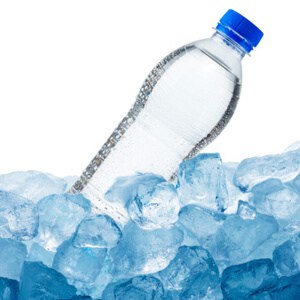
- Classification: Food Product
- Regulating Agency: Food & Drug Administration in the U.S. (FDA)
- Consumed: 11 billion gallons annually
- Recycled: Less than 20%
- Market: Worldwide
- Market Share: 29% of U.S. bottled beverage market
- Shelf Life: Indefinite
- Fluoride: None, or less than optimal levels
- Waste: 1.5 million tons of plastic waste annually
- Cost: More than 1,000 times more than tap water
- Types: Spring water, purified water, distilled water, mineral water
- Harmful Effects: Depletion of fossil fuels, production of carbon dioxide
- Safety: Bottled Water is NOT safer than tap water
- Convenience: Bottled Water is highly convenient for consumers
- Market Share: Bottled Water is second largest commercially bottled beverage in the US
- Source: Approximately 45% of Bottled Water comes from municipal water sources
- Labelling: Bottled Water labelling can be misleading
- Chemicals: Plastic water bottles may contain cancer-causing chemicals
- Fluoride: Bottled Water does not contain Fluoride – An essential Nutrient for strong bones and teeth
- Classifications: There are many types of Bottled Water on the market
- Storage: Proper Bottled Water storage is an important safety issue
- Natural Disasters: Bottled Water provides a safe source of drinking water
- Bottled Water is 4,000 times more expensive than tap water
- Less than 20% of all plastic water bottles are Recycled
- Bottled Water production uses over 17million barrels of oil and 1 million tons of plastic
- Bottled Water production uses valuable Natural resources
- Bottled Water costs US cities millions of dollars each year
Bottled Water Infographics

Bottled Water is NOT safer than tap water
Contrary to popular belief, bottled water facts show that bottled water is not actually safer to drink than tap water. While tap water in the U.S. is regulated by the EPA (Environmental Protection Agency), bottled water falls under the control of the FDA (Food & Drug Administration).
Although both undergo strict treatment and testing, tap water is held to a higher standard than bottled water under the requirements of the Safe Drinking Water Act, a federal law enacted in 1974 to ensure the quality of the nation’s drinking water.
Bottled Water is Highly Convenient for Consumers
According to public opinion polls, convenience is the number one reason consumers drink bottled water. Bottled water is portable, easy to measure, comes with a resealable cap, and does not expire, all of which makes it easy to carry around and consume on the go while theoretically increasing water consumption, a big plus for busy, health-conscious consumers.
Bottled Water is the Second Largest Commercially Bottled Beverage in the U.S.

Bottled water is the fastest growing bottled beverage industry in the U.S. Each year, more than 11 billion gallons of bottled water are sold in the U.S., accounting for approximately 29% of the nation’s bottled beverage market, which is second only to soft drinks and just ahead of coffee, milk, and beer.
Bottled water facts reveal that this beverage is one of the world’s most successfully marketed products. Consumption of bottled water rose by an estimated 7% in 2014, resulting in wholesale sales revenues of approximately 13 billion dollars!
Approximately 45% of Bottled Water Comes from Municipal Water Sources
Of the more than 11 billion gallons of bottled water sold in the U.S. each year, nearly half comes from municipal water sources – the very same sources that supply tap water to U.S. homes and businesses. A smaller percentage of bottled water comes from natural underground sources, such as springs or aquifers. This type of bottled water often contains beneficial salts and minerals and may or may not have undergone further treatment or processing.
Bottled Water Labelling Can be Misleading
Misrepresentation by bottled water manufacturers is an ever-growing concern for consumers. While definitely at a disadvantage when it comes to faulty or inaccurate labeling, consumers can fight back by arming themselves with knowledge about bottled water products. According to the FDA, terms such as “glacier water” and “mountain water” are not officially acknowledged by regulating industries and should not be considered a true representation of the source or purification level of the product. Bottled water companies recently held accountable for misrepresentation include Nestlé, PepsiCo, and Coca-Cola. Complaints include false labeling and the intentional misleading of consumers regarding the source and superiority of bottled water.
Plastic Water Bottles May Contain Cancer-Causing Chemicals
Plastic bottles used by the bottled water industry are made from PET (polyethylene terephthalate), a plastic resin commonly used in the manufacturing of plastic products. Although PET has been approved by the FDA for use in the production of food contact plastics, studies show PET products may allow known cancer-causing agents such as dioxin to leach into the water, putting consumers at risk.
Bottled Water Does Not Contain Fluoride – An Essential Nutrient for Strong Bones & Teeth
Bottled water facts reveal that, according to the CDC (Centres for Disease Control and Prevention), bottled water products labeled as purified, demineralised, de-ionised, or distilled contain little or no fluoride. While the majority of municipal drinking water in the U.S. is treated with fluoride, this is not a requirement for bottled water producers. In fact, commonly used purification methods such as reverse osmosis and distillation actually remove all traces of fluoride from bottled water during the treatment process.
There Are Many Types of Bottled Water on the Market
Bottled water is classified by type, according to source, characteristics, and treatment methods. Bottlers are required by law to indicate the bottled water type on the label and to provide full disclosure when the water comes from a public water system.
The four main classifications of bottled water are spring water – water derived from an underground source that may or may not be treated; purified water – water from any source that has been purified and is essentially free of chemicals; distilled water – water that has been boiled and recondensed; and mineral water – naturally occurring ground water containing dissolved salts and minerals.
Proper Bottled Water Storage Is an Important Safety Issue
Unopened bottled water should be stored in a cool, dry place, away from combustible solvents or chemicals, and should not be subjected to extreme changes in temperature. Bottled water facts teach us that excessive heat can cause cancer-causing dioxins contained in the plastic bottle to release and leach out into the water. When properly stored, bottled water will keep indefinitely and does not expire.
Bottled Water Provides a Safe Source of Drinking Water

While bottled water is not generally recommended over tap water, it may be the better choice under certain circumstances. During times of natural disaster, such as floods or earthquakes, public drinking water may be contaminated, leaving bottled water as the only available source of safe drinking water. Bottled water is also recommended for camping trips and journeys to parts of the world where safe drinking water is not readily available.
Bottled Water is 4,000 Times More Expensive than Tap Water
One of the more shocking bottled water facts demonstrates just how expensive this popular drink is. At an average price of $8.00 per gallon, bottled water is ridiculously expensive when compared to tap water, which generally costs less than one cent per gallon. To put things in perspective, if the price of a gallon of tap water was equal to that of a gallon of bottled water, the average household water bill would run in excess of $9,000 per month!
Less than 20% of All Plastic Water Bottles are Recycled

Studies show that while health-conscious Americans are consuming more and more bottled water each year, they are actually recycling fewer and fewer plastic bottles. On average, 70 million bottles of water are consumed daily in the U.S. Of those, most end up in landfills, where they take as long as 1,000 years to decompose, while others are incinerated, creating toxic fumes that are released into the Earth’s atmosphere, posing significant risks to consumers and the ozone. Still others end up in lakes, rivers, and oceans, where bottled water facts show us they can cause devastating harm to animal life and the environment.
Bottled Water Production Uses Over 17 Million Barrels of Oil and 1 Million Tons of Plastic
Studies show that it takes 2,000 times more energy to produce bottled water than it does to produce tap water. More than 17 million barrels of crude oil are used annually in the production of bottled water, enough to fuel about 1.5 million cars for a year. The bottled water industry produces over one million tons of plastic bottles, as well, which in turn produce more than 2.5 million tons of carbon dioxide, roughly the same amount produced by 400,000 cars.
Bottled Water Production Uses Valuable Natural Resources
Every year, huge amounts of fossil fuels are used in the production and transportation of bottled water. By definition, fossil fuels are hydrocarbons that form from the decomposition of dead plants and animals. In truth, they are one of the world’s most valuable natural resources. Fossil fuels produce coal, oil, and natural gas, important energy sources we use to fuel our vehicles, heat our homes, and power our industries. At the present rate of consumption, fossil fuel sources will be exhausted long before they can be replenished.
Bottled Water Costs U.S. Cities Millions of Dollars Each Year
The far-reaching effects of bottled water are impacting cities and towns across the U.S. The same cities that provide consumers with environmentally safe and healthy drinking water at a cost of about $0.002 per gallon are now spending more than 70 million dollars of taxpayer money each year cleaning up and disposing of the countless plastic water bottles that find their way to landfills, roadsides, rivers, lakes, and streams.
Bottled Water Facts – Facts about Bottled Water Summary
 Although bottled water has been around for centuries in Europe, it didn’t become common in the U.S. until the mid-1970s, when small regional bottlers began producing it in earnest. By the early 1990s, bottled water had become a cultural icon of fitness and health, ranking second in popularity to soft drinks and significantly ahead of milk, coffee, and beer. While the popularity of bottled water has continued to rise, health, economic, and environmental concerns have taken centre stage in recent years, raising consumer awareness about the damaging effects of extensive bottled water production.
Although bottled water has been around for centuries in Europe, it didn’t become common in the U.S. until the mid-1970s, when small regional bottlers began producing it in earnest. By the early 1990s, bottled water had become a cultural icon of fitness and health, ranking second in popularity to soft drinks and significantly ahead of milk, coffee, and beer. While the popularity of bottled water has continued to rise, health, economic, and environmental concerns have taken centre stage in recent years, raising consumer awareness about the damaging effects of extensive bottled water production.
Was this page helpful?
Our commitment to delivering trustworthy and engaging content is at the heart of what we do. Each fact on our site is contributed by real users like you, bringing a wealth of diverse insights and information. To ensure the highest standards of accuracy and reliability, our dedicated editors meticulously review each submission. This process guarantees that the facts we share are not only fascinating but also credible. Trust in our commitment to quality and authenticity as you explore and learn with us.
